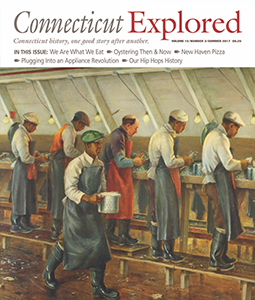(c) Connecticut Explored Summer 2017
Subscribe/Buy the Issue!
Harriet Beecher Stowe and Catherine Beecher’s The American Woman’s Home, published in 1869, was a pioneering work of home economics. The book was known for its innovative ideas about kitchen design, which captured the attention of home-owners for decades. For years the Harriet Beecher Stowe Center interpreted the kitchen in Stowe’s house through the lens of The American Woman’s Home. That is, until July 2014.
The Stowe Center decided to scrap its traditional tour in favor of a new visitor experience that better met the museum’s mission, which is to use the author’s work to inspire commitment to social justice and positive change. The way information is presented in various rooms shifted focus. Interactive elements were added to help visitors become more active participants. The study in which Calvin Stowe (Harriet’s husband) worked, for example, became a multimedia room; the front parlor became a place not just to showcase family decorative arts such as Stowe’s paintings but a space for close reading of such documents as a photograph of emancipated children or a reward poster for individuals escaping slavery.
The kitchen is the last room on the tour, and it appears as it would have in Stowe’s day. A coal-burning stove sits at one end, and a large kitchen table occupies the center. And though the kitchen was a critical room in The American Woman’s Home, Stowe employed African American, Irish, and German women to work in the kitchen.
If the 19th-century conversation space was the parlor, then the 21st-century conversation space is the kitchen. Sometimes referred to as “the heart of the home,” the kitchen is where we gather, eat, talk, and share. Visitors therefore are invited to take a seat at the table. After a brief introduction to the space, visitors are asked to think about all they’ve learned on the tour, about Stowe’s life, slavery in the U.S., and the implications of Uncle Tom’s Cabin. They are asked what they care about as citizens of the world today and what social justice means to them. They are invited to write their thoughts on the craft paper that covers the table.
 At the Harriet Beecher Stowe Center, we’ve found the kitchen to be a good place for this reflective activity. But in both Stowe’s time and today kitchens are not neutral spaces; nor are these kitchen conversations neutral. In a time of political contention, our kitchens serve as spaces for debate about anything from President Donald Trump to health care or immigration. The Stowe Center’s kitchen conversations do not offer conclusions or answers. Instead, we hope participants are inspired by the experience to continue their conversations beyond the walls of the house and transform those conversations into action.
At the Harriet Beecher Stowe Center, we’ve found the kitchen to be a good place for this reflective activity. But in both Stowe’s time and today kitchens are not neutral spaces; nor are these kitchen conversations neutral. In a time of political contention, our kitchens serve as spaces for debate about anything from President Donald Trump to health care or immigration. The Stowe Center’s kitchen conversations do not offer conclusions or answers. Instead, we hope participants are inspired by the experience to continue their conversations beyond the walls of the house and transform those conversations into action.
Maura Hallisey was a program coordinator at the Harriet Beecher Stowe Center and is a 2013 graduate of Connecticut College.
LISTEN
Hear Executive Director Katherine Kane talk about the revolutionary new tour visitors experience at the Harriet Beecher Stowe Center in Grating the Nutmeg, episode 31.
MORE ABOUT HARRIET BEECHER STOWE
“The Most Famous American,” Summer 2011
“Where Mr. Twain and Mrs. Stowe Built Their Dream Houses,” Summer 2011
“A Tomitude,” Fall 2002
“Lincoln and the Key to Uncle Tom’s Cabin,” Winter 2012/2013

